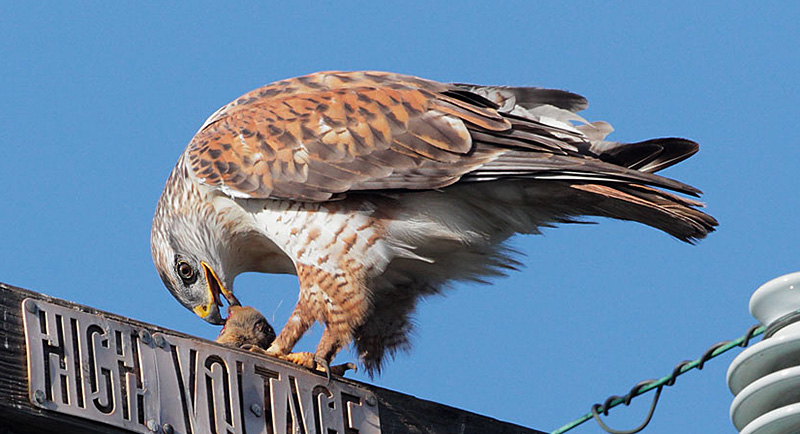Ferruginous Hawks are large-sized hawks. In fact, this hawk is the largest in North America. They have large heads, long wings, and the wings more pointed and narrow than other types of hawks.
These birds are found in deserts and prairies and they hunt from a single rock outcrop, tree, or high in the sky.
On this page
Identification
Male and female adult Ferruginous Hawks look identical and are the same size. This can make it hard to identify the sex. These birds are smaller than Golden Eagles but larger than a Swainson’s Hawk.
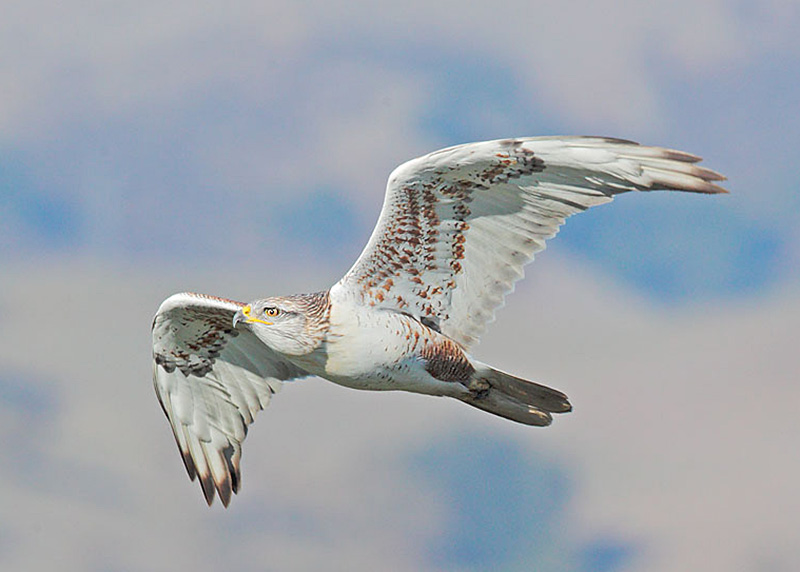
Photograph © Tom Grey.
They have large heads and long wings. Ferruginous Hawks with light morph have notable rusty legs and white underparts. The birds legs form a V when the bird is in flight. These birds have pale heads and rusty underparts. Juvenile Ferruginous Hawks with light morph have brown spotting on the legs and belly that varies.
Dark-morph individuals can be seen but they’re much rarer than light-morph individuals. The dark-morph birds are overall a deep orange-brown color. White panels can be see in the outer wing that are caused by the white bases on the primary feathers.
Food
Ferruginous Hawks’ diet is pretty simple. They consume small mammals like hares, rabbits, ground squirrels, pocket gophers, and prairie dogs.
East of the continental divide, they eat mostly prairie dogs and ground squirels. West of the continental divide, their main prey items are cottontail rabbits and jackrabbits. These birds also consume reptiles, amphibians, birds, and insects.
Ferruginous Hawks hunt at any point of the day. While flying, they’ll either hover or kite in place, utilize a nearby perch, or stand on the ground. They’ll sometimes even hop, walk, or run on the ground after their prey as well.
Nesting and Eggs
Male and female Ferruginous Hawks will choose their nesting site together. They’ll place their nests in either a cliff, lone tree, utility structure, boulder, outcrop, knoll, haystack, or shrub.
Ferruginous Hawk nest heights can vary greatly. They can be ground level or as high as 65 feet. Ground nests are nearly always on hill crests or slopes. Nests that are high up are built on the remnants of other birds nests.
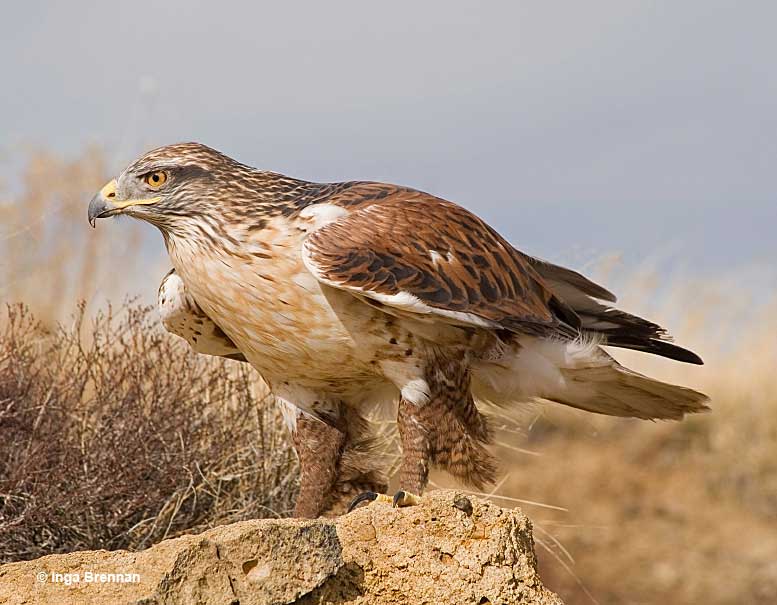
Both the male and the female will build the nest. The male will bring most of the materials for the nest and the female will do most of the construction. Nest materials include twigs, sticks, old sagebrush stems, metal debris, bones, and plastic debris.
On average, nests are 3 feet tall and 3 feet wide. They may even be brodered with sod, bark, and cow dung. Construction usually takes less than a week but if they’re interrupted, they may abandon the nest they were buidling and go create a new one.
For Ferruginous Hawks, the number of eggs can vary from 1 to 8. The parents incubate the eggs for roughly 33 days. After that, the young hawks stay in the nest for up to 50 days.
Current Situation
Ferruginous Hawks are birds that inhabit sagebrush country, grasslands, edges of pinyon-juniper forests, and saltbush-greasewood shrublands. During their breeding season, they inhabit outcrops, tree groves, and cliffs, for nesting.
West of the Rocky Mountains, these birds winter in deserts or grasslands that have an abundance of pocket gophers, prairie dogs, and rabbits. East of the Rocky Mountains they primarily live in grasslands that have an abundance of prairie dogs.
The Ferruginous Hawk population has increased by almost 1% every year since the early 1960s. They’re estimated global population is 110,000, meaning they’re a species of low concern for now.
Hunting died down for these birds in the twentieth century when it became illegal becuase of the Migratory Bird Treaty Act. However, there is still a risk of population decline for these birds.
There have been changes to Ferruginous Hawk nesting habitats because of grazing, agriculture, small mammal control, fire, and mining which can contribute to a decline of the regional population.
Facts
- During the winter months, groups of 5 to 10 Ferruginous Hawks will come together in towns of prairie dog. They’ll strike prey when they emerge. During this time, they’ll threaten each other by flapping their wings ot hopping. This will create a feeding frenzy that can even attract other raptors.
- Ferruginous Hawk used bison bones in their nests and along with sticks and twigs when bison still roamed the west.
- Rough-legged Hawks, Golden Eagles, and Ferruginous Hawks are the only Noth American birds that have feathers on their legs all the way down to their toes.
- The Upland Buzzard of Central Asia rivals the Ferruginous Hawk in size. They may be a close relative from the days when the Alaska–Siberia land bridge existed. Ferruginous Hawk fossils have been found across the west and have been calculated to date back to the late Pleistocene period.
Similar Species
The Ferruginous Hawks have features that are similar to other bird species. Here are some similar species:
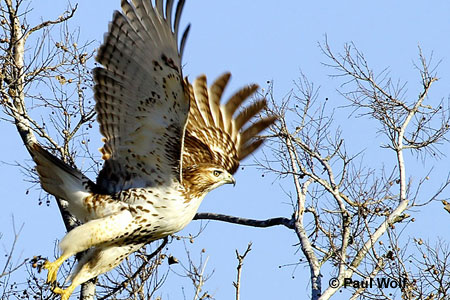
red-tailed hawk
Ferruginous Hawks have longer, squarer wings than Red-tailed Hawks.
They also have rust-streaked or pale underparts, while Red-tailed Hawks have dark streaks on the belly.
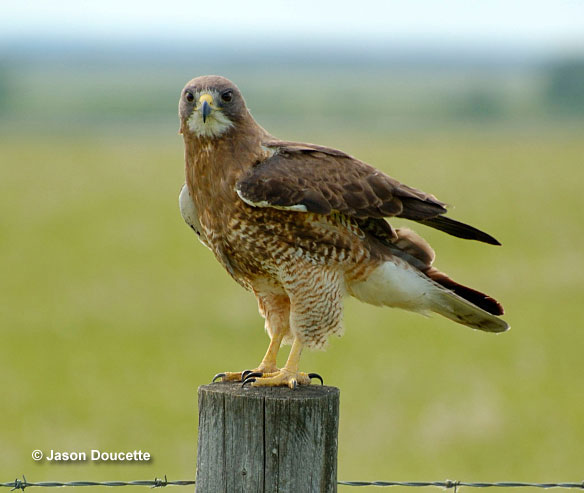
Swainson’s Hawk
Ferruginous Hawks are similar in shape to Swainson’s Hawks. However, their color patterns are extremely different.
Swainson’s Hawks have a dark band at the tip of their tail, brown upper breast, and two-toned wings.
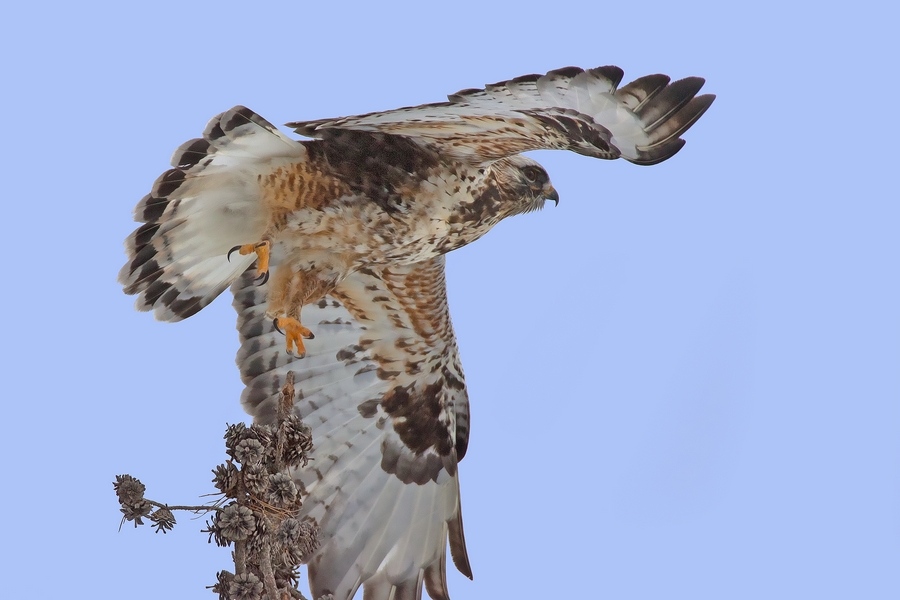
Rough-legged Hawk, Near Logan Lake, British Columbia
Ferruginous Hawks are plumper than Rough-legged Hawks.
Ferruginous Hawks have pale underparts, while Rough-legged Hawks have large markings on the breast and a dark band at the end of the tail.
Frequently Asked Questions
Are Ferruginous Hawks rare?
No, Ferruginous Hawks are not rare. Additionally, they’re not afraid of humans, making them pretty easy to see.
Where do Ferruginous Hawks live?
Ferruginous Hawks live in sagebrush country, grasslands, edges of pinyon-juniper forests, and saltbush-greasewood shrublands. During their breeding season, they inhabit outcrops, tree groves, and cliffs, for nesting.
What is Ferruginous Hawk’s wingspan?
Ferruginous Hawks have a wingspan that ranges from 52.4 to 55.9 inches (133 to 142 centimeters).
How big are Ferruginous Hawks?
Ferruginous Hawks are very large birds. In fact, it is the largest hawk in North America.

